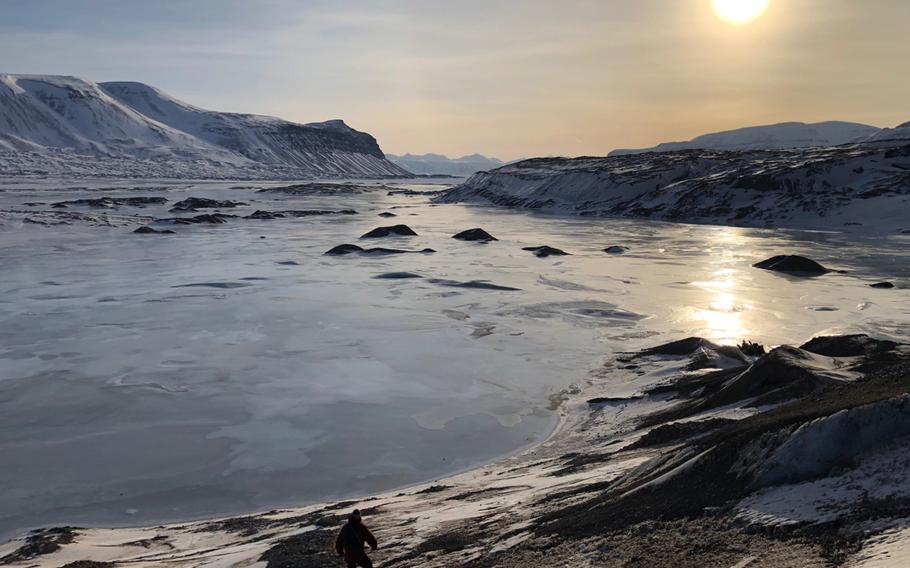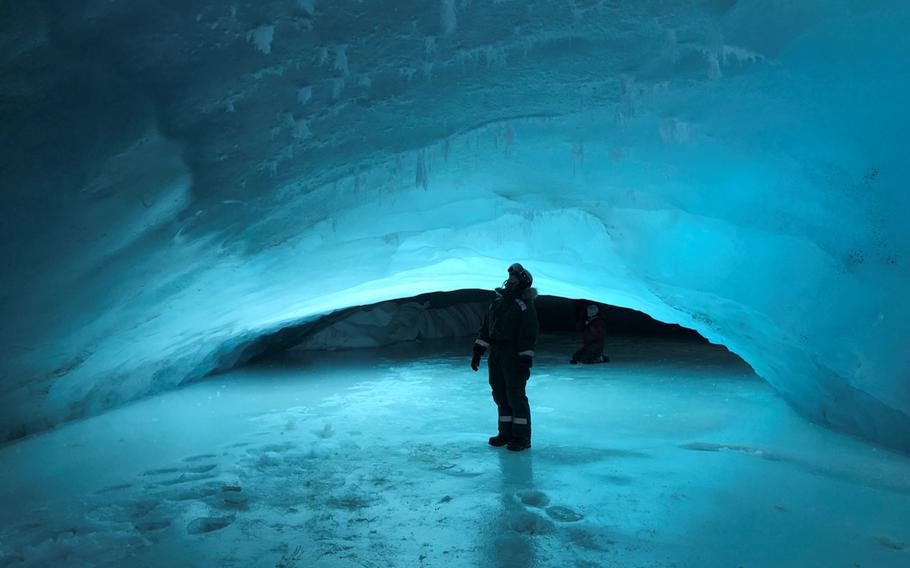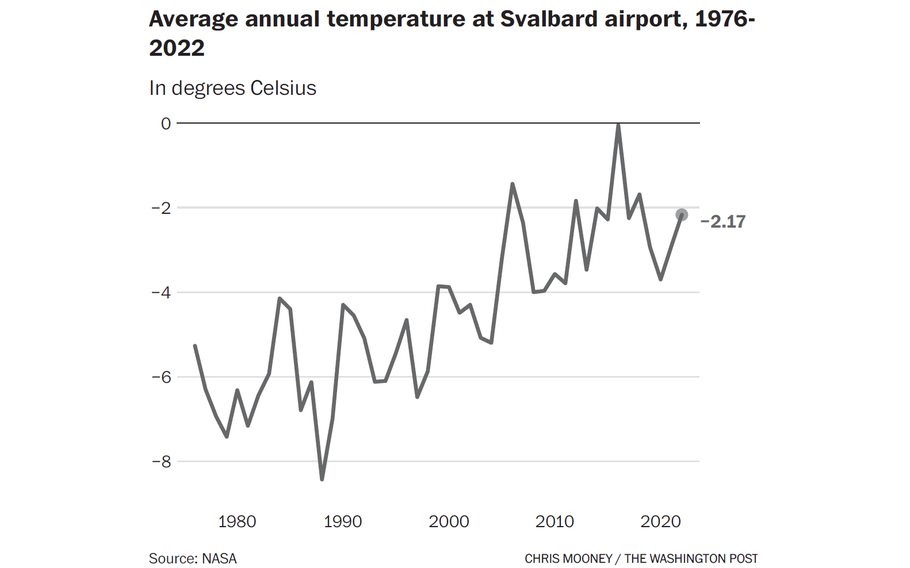
Large proglacial icing in the forefield of a glacier on Svalbard, Norway. As Arctic glaciers melt, they are unlocking huge volumes of ancient methane gas, which contributes to rising temperatures. (Gabrielle Kleber)
Scientists working in one of the world’s fastest-warming places found that rapidly retreating glaciers are triggering the release into the atmosphere of methane, a potent greenhouse gas that causes global temperatures to rise.
The releases are triggered as glaciers across the archipelago of Svalbard, Norway, rapidly retreat and leave behind newly exposed land, scientists said. If the phenomenon is found to be more widespread across the Arctic — where temperatures are quickly rising and glaciers melting — the emissions could have global implications.
As the Svalbard glaciers move and land is left behind, groundwater beneath the Earth seeps upward and forms springs. In 122 out of 123 of them, the scientists found, the water is filled with apparently ancient methane gas at very high concentrations that bubble upward under pressure. The amount of emissions these springs are emitting are not well-quantified.

Glacier cave on Svalbard, Norway. (Gabrielle Kleber)
“This is a feedback loop that’s caused by climate change,” said Gabrielle Kleber, the study’s lead author and a scientist based at the University of Cambridge and the University Centre in Svalbard. “Glaciers are retreating due to climate warming, and they are leaving these exposed forefields behind, which are encouraging methane gas to be released.”
Most concerning is the apparent age of the methane — the fact that it appears to be ancient suggests it could be coming from very large underground reservoirs with the potential to unleash a lot of gas. The researchers found that the most intense gas flows occurred in regions with underground shale layers that are millions of years old.
“It’s not methane being produced contemporarily by microbes, it’s methane that was created when the rocks were formed,” Kleber said.
This implies that the gas has been sequestered for long periods in ancient deposits of fossil fuels, principally natural gas and coal — but that something has recently removed what scientists call a “cryospheric cap,” once provided by glaciers or permafrost. It kept a lid on the methane, and its removal allowed the once stable gas to escape upward. Svalbard is widely known to be rich in fossil fuels — the largest settlement, Longyearbyen, was originally established as a coal-mining town.
Scientists said the current phenomenon could certainly be happening in many places other than Svalbard, potentially adding another accelerator of warming in the Arctic.
“Shale is Earth’s most abundant rock, and there’s plenty of it in the Arctic (or rocks like it),” said Andy Hodson, a co-author of the study and also a scientist at Norway’s University Centre in Svalbard.
The study was published on Thursday in Nature Geoscience by Kleber, Hodson and colleagues based at universities in Norway, Canada and the United Kingdom. The scientists studied 78 Svalbard glaciers that are based on land in the course of their research and several additional glaciers that stretch all the way into the ocean.
If the methane releases represent a new phenomenon tied to the warming of the planet, Svalbard is an appropriate place for it. The string of islands has seen extraordinary warming, causing the strong retreat of glaciers. Svalbard has warmed dramatically since 1976, based on temperature measurements taken at the Svalbard airport near Longyearbyen.

(Chris Mooney/The Washington Post)
There is no official quantification of how large methane emissions from retreating glaciers around the world could be. The phenomenon would add an additional source of methane emissions in the Arctic.
Scientists have found that thawing permafrost also releases the gas into the atmosphere, but the phenomenon is not well understood. An official scientific assessment puts those at between zero and 1 million tons of methane per year, underscoring the uncertainty about the scope of the problem.
The emissions from retreating glaciers would count as a different source — there is usually no permafrost beneath the glaciers, Kleber said. Rather, the glacier ice itself, which crushes the ground downward, is serving as the apparent cap holding the methane in.
Kleber and colleagues estimate that 2,310 tons of methane could be emitted in Svalbard each year due to the process they have uncovered. By comparison, Norway reported 105,940 tons of methane emissions from its agricultural sector, the largest source of emissions for this gas, in 2021, the most recent year of reporting.
Overall, the emissions tied to retreating glaciers in Svalbard would constitute a little over 1% of all of Norway’s methane emissions for 2021. Among nations, Norway is itself a relatively small methane emitter.
The real fear is not what is happening in Svalbard, but rather, what it would mean if the phenomenon is more widespread — or, if it is poised to worsen due to further glacial retreat. Kleber notes, for instance, that glaciers that currently spill into the ocean are also retreating, in many cases backing up onto land and thus once again exposing land surfaces that could have methane beneath them.
“As more land is exposed, we have more springs that will pop up,” said Kleber.
The new results bump up our understanding of how much older methane could be leaking into the atmosphere in the Arctic as the planet warms, said Katey Walter Anthony, a researcher at the University of Alaska, Fairbanks, who studies these emissions across the less-and-less frozen north.
In one case, Walter Anthony documented a bubbling lake in Alaska that was also emitting ancient, geologic methane at the alarming rate of nearly 11 tons of gas per day.
The latest study “is important because it shows how ubiquitous (methane) seeps, of various origins, are in the environment of retreating glaciers,” Walter Anthony said in an email. “Similar methane rich seeps have been found in Alaska and Greenland along margins of glaciers and the ice sheet.”
In a 2012 study, Walter Anthony and a team of scientists estimated that 2 million tons per year of ancient methane gas, stored deep beneath the earth, could be seeping into the air across the Arctic as permafrost thaws, new lakes form and other changes provide new paths for it to reach the atmosphere. Based on the new study, Anthony now says that figure could be much larger.
“This emission pathway has basically gone under the radar until now,” added Jesper Riis Christiansen, a scientist with the University of Copenhagen who has studied methane emissions tied to Greenland glaciers. “It’s only been within the last seven years that people have actually studied this.”
However, Christiansen said the authors could do more to prove that the methane they are finding is very old, as the paper suggests.
The age of the gas matters because scientists believe the methane beneath the Earth that is linked with fossil fuel deposits — but that is not the same as methane emissions nearer to the surface that are being produced by microorganisms all the time.
“There’s still some pieces of this puzzle that are missing,” Christiansen said.
And the research continues, against the picturesque but also wild background of Svalbard, which is known for its large population of polar bears. Speaking from Rindersbukta, a fjord in Svalbard where a series of glaciers terminate, Kleber noted that the temperatures were close to 60 degrees Fahrenheit that day, “extremely hot for a Svalbard summer. The rivers are raging.”
“It’s just a kind of bleak concept to watch these hundreds of cubic meters of water flashing before our eyes and knowing in our current climate, that’s ice that will never be replaced,” Kleber continued. “And then we have these methane springs bubbling up before the glacier.”